Rabbit calicivirus
| Rabbit hemorrhagic disease virus | |
|---|---|
 |
|
| CryoEM reconstruction of Rabbit Hemorrhagic Disease Virus (RHDV) capsid. EMDB entry EMD-1933 | |
| Virus classification | |
| Group: | Group IV ((+)ssRNA) |
| Order: | Unassigned |
| Family: | Caliciviridae |
| Genus: | Lagovirus |
| Species: | Rabbit hemorrhagic disease virus |
Rabbit haemorrhagic disease (RHD), also known as rabbit calicivirus disease (RCD) or viral haemorrhagic disease (VHD), is a highly infectious and often fatal disease that affects wild and domestic rabbits of the species Oryctolagus cuniculus. The infectious agent responsible for the disease is rabbit haemorrhagic disease virus (RHDV), or rabbit calicivirus (RCV), genus Lagovirus of the family Caliciviridae. The virus infects only rabbits, and has been used in some countries to control rabbit populations.
RHD first appeared in the Winter of 1983 in Jiangsu Province of the People's Republic of China. It was first isolated and characterized by S.J. Liu et al. in 1984. The Chinese outbreak was spread by the angora rabbit, which had originated in Europe. Fourteen million domesticated rabbits died within nine months in the outbreak.
In 1984 the virus that caused the disease was identified. The virus spread westward and reached Europe in 1988. The virus has since appeared in Mexico, Cuba, Australia, New Zealand and the United States. In 1992, the United Kingdom reported its first case of RHD in domestic show rabbits. By the late 1990s, RHD stretched to forty countries and had become endemic in wild and feral rabbit populations in Europe, Australia, New Zealand and Cuba. In Europe, there was a rapid increase in research into RHD, due to the importance of the commercial breeding of rabbits for meat and fur production.
The first reported case in the United States was in Iowa on March 9, 2000. The affected breeds included Palominos and California Whites. By April 6, 25 of the 27 affected rabbits had died of the infection. In order to contain the disease, the remaining two rabbits were euthanized. No new introductions of rabbits were placed on the farm for two years after the discovery of RHD and August 1999 was the last time rabbits left and/or returned to the farm. The United States experienced other outbreaks of RHD in 2001 (Utah, Illinois, New York) and 2005 (Indiana).
...
Wikipedia
